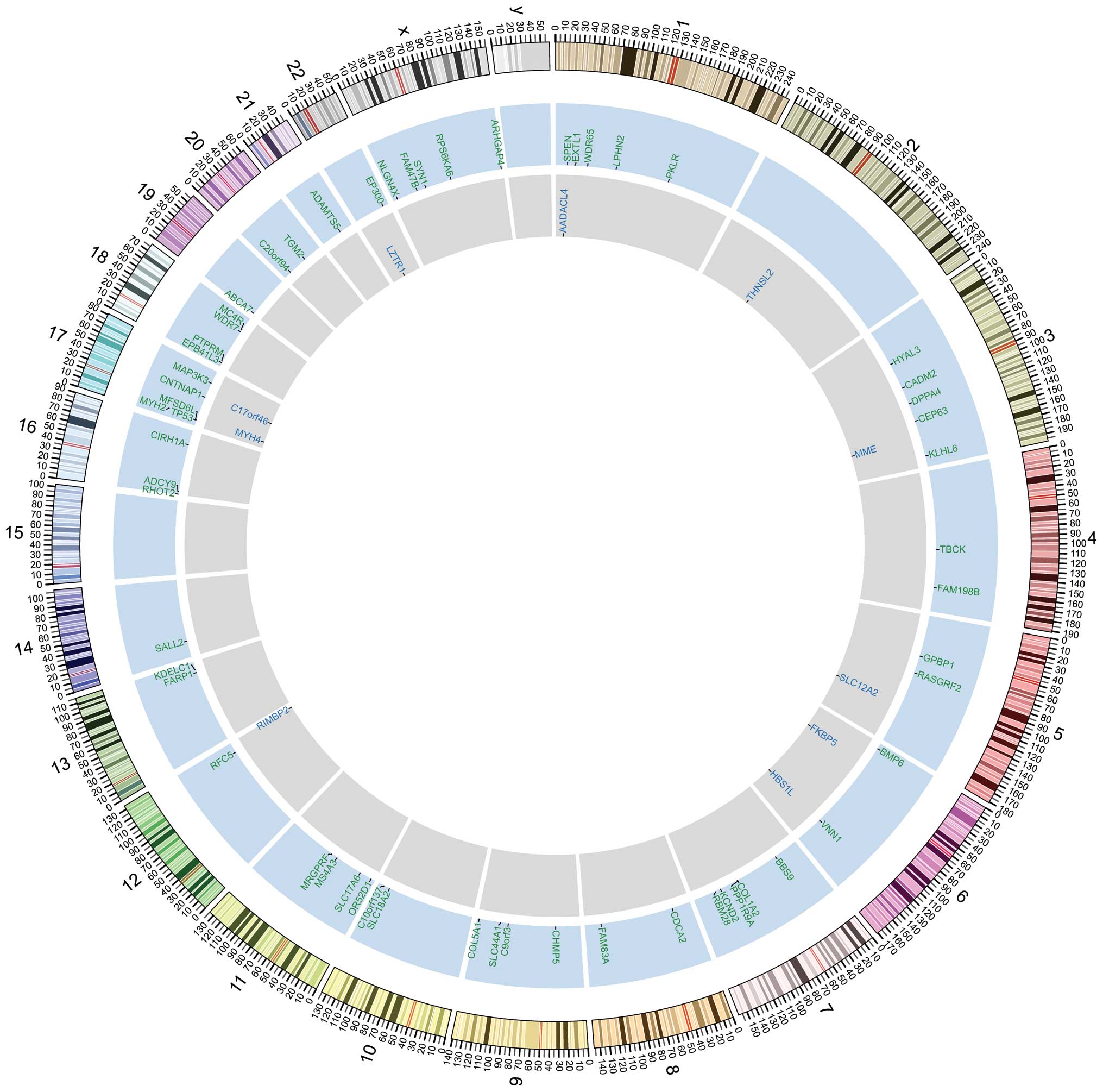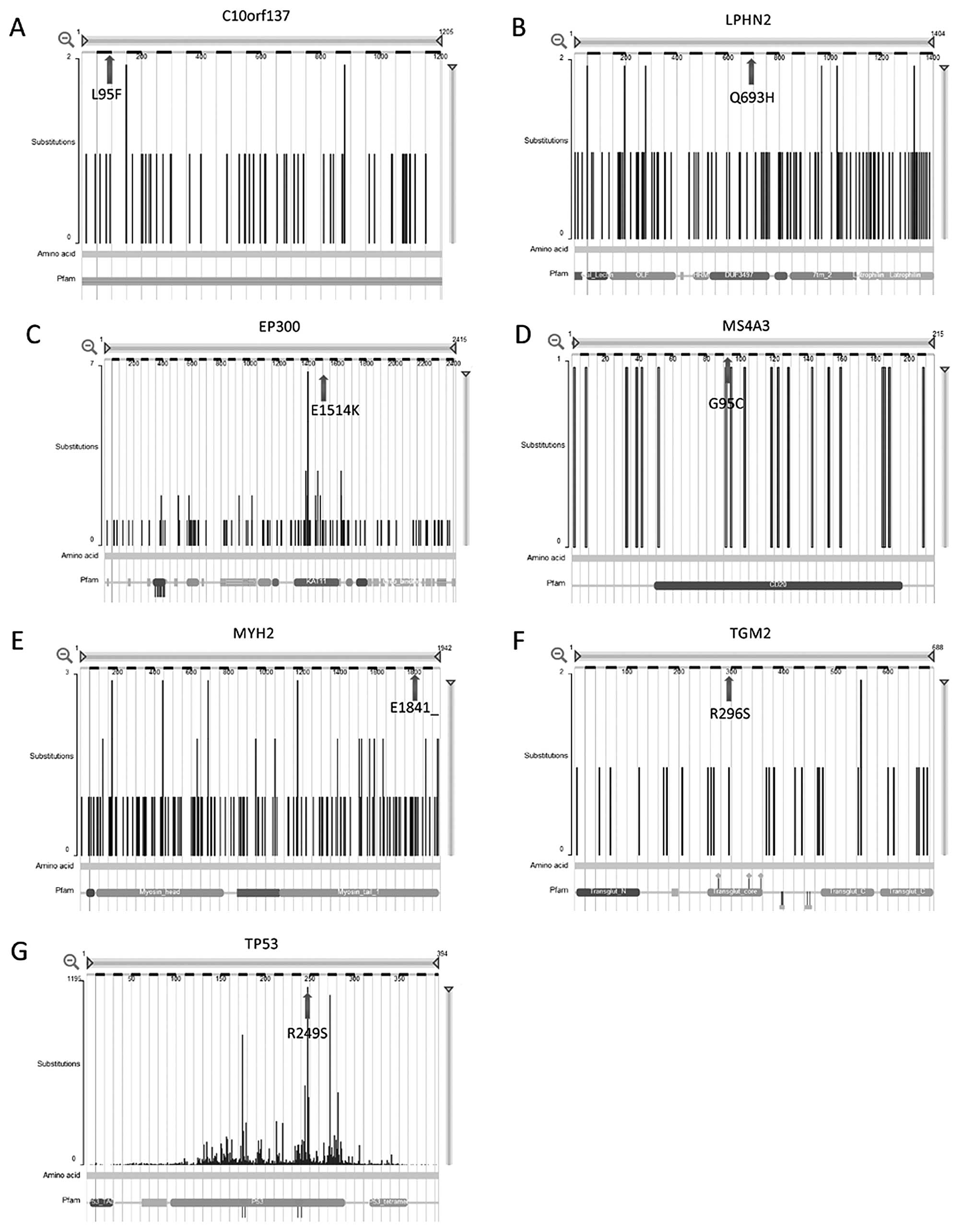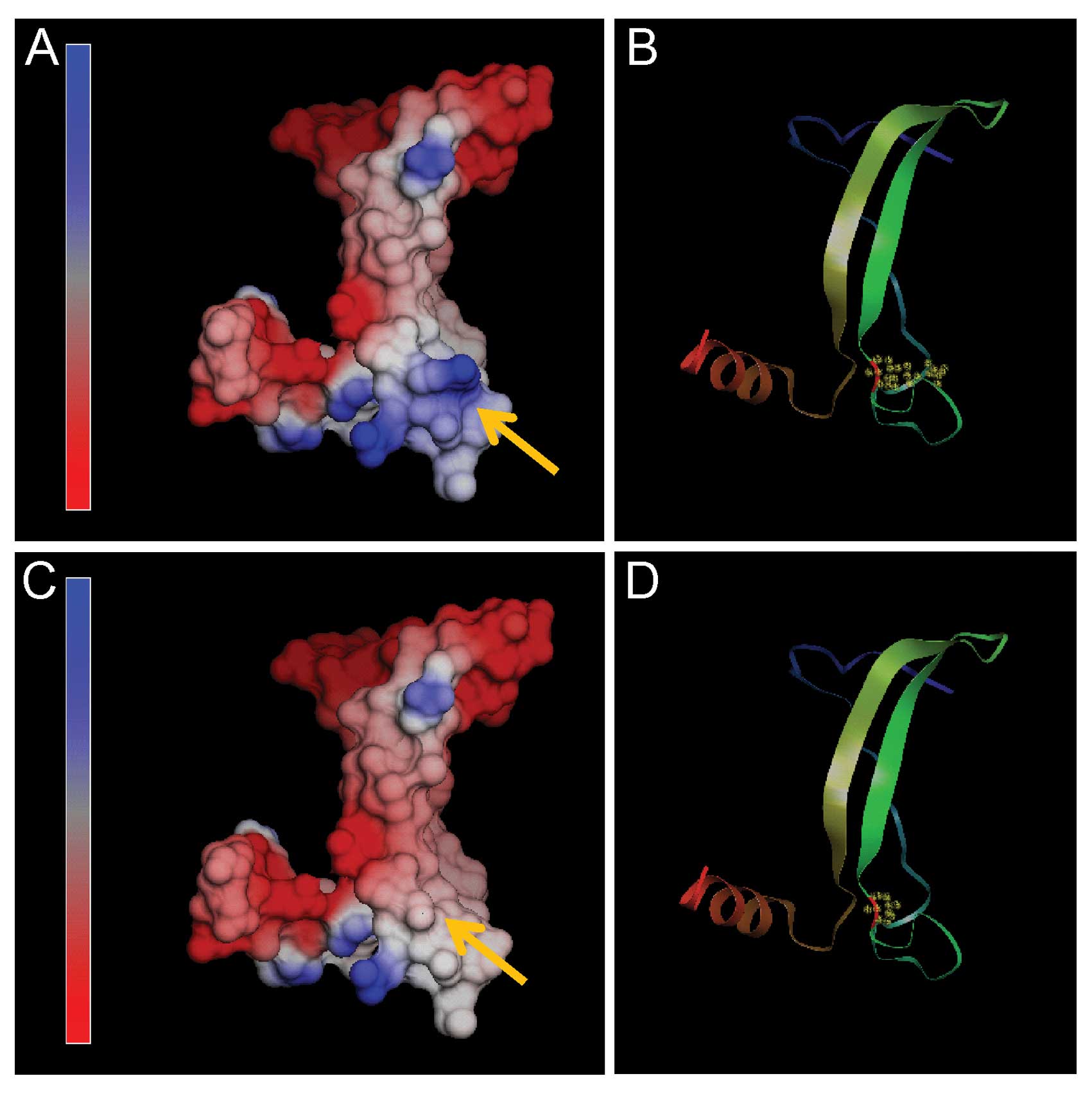|
1
|
Borczuk AC, Toonkel RL and Powell CA:
Genomics of lung cancer. Proc Am Thorac Soc. 6:152–158. 2009.
View Article : Google Scholar : PubMed/NCBI
|
|
2
|
Satouchi M, Negoro S, Funada Y, et al:
Predictive factors associated with prolonged survival in patients
with advanced non-small-cell lung cancer (NSCLC) treated with
gefitinib. Br J Cancer. 96:1191–1196. 2007. View Article : Google Scholar : PubMed/NCBI
|
|
3
|
Shaw AT, Yeap BY, Mino-Kenudson M, et al:
Clinical features and outcome of patients with non-small-cell lung
cancer who harbor EML4-ALK. J Clin Oncol. 27:4247–4253. 2009.
View Article : Google Scholar : PubMed/NCBI
|
|
4
|
Ji H, Wang Z, Perera SA, et al: Mutations
in BRAF and KRAS converge on activation of the mitogen-activated
protein kinase pathway in lung cancer mouse models. Cancer Res.
67:4933–4939. 2007. View Article : Google Scholar : PubMed/NCBI
|
|
5
|
Felip E, Gridelli C, Baas P, Rosell R and
Stahel R; Panel Members. Metastatic non-small-cell lung cancer:
consensus on pathology and molecular tests, first-line,
second-line, and third-line therapy. Ann Oncol. 22:1507–1519. 2011.
View Article : Google Scholar : PubMed/NCBI
|
|
6
|
Rekhtman N, Paik PK, Arcila ME, et al:
Clarifying the spectrum of driver oncogene mutations in
biomarker-verified squamous carcinoma of lung: lack of EGFR/KRAS
and presence of PIK3CA/AKT1 mutations. Clin Cancer Res.
18:1167–1176. 2012. View Article : Google Scholar : PubMed/NCBI
|
|
7
|
James J, Ruggeri B, Armstrong RC, et al:
CEP-32496: a novel orally active BRAF(V600E) inhibitor with
selective cellular and in vivo antitumor activity. Mol Cancer Ther.
11:930–941. 2012. View Article : Google Scholar : PubMed/NCBI
|
|
8
|
Shibata T, Ohta T, Tong KI, Kokubu A,
Odogawa R, Tsuta K, Asamura H, Yamamoto M and Hirohashi S: Cancer
relatedmutations in NRF2 impair its recognition by Keap1-Cul3 E3
ligase and promote malignancy. Proc Natl Acad Sci USA.
105:13568–13573. 2008. View Article : Google Scholar : PubMed/NCBI
|
|
9
|
Kan Z, Jaiswal BS, Stinson J, et al:
Diverse somatic mutation patterns and pathway alterations in human
cancers. Nature. 466:869–873. 2010. View Article : Google Scholar : PubMed/NCBI
|
|
10
|
Dutt A, Ramos AH, Hammerman PS, et al:
Inhibitor-sensitive FGFR1 amplification in human non-small cell
lung cancer. PLoS One. 6:e203512011. View Article : Google Scholar : PubMed/NCBI
|
|
11
|
Hammerman PS, Sos ML, Ramos AH, et al:
Mutations in the DDR2 kinase gene identify a novel therapeutic
target in squamous cell lung cancer. Cancer Discov. 1:78–89. 2011.
View Article : Google Scholar : PubMed/NCBI
|
|
12
|
Weiss J, Sos ML, Seidel D, et al: Frequent
and focal FGFR1 amplification associates with therapeutically
tractable FGFR1 dependency in squamous cell lung cancer. Sci Transl
Med. 2:62ra932010. View Article : Google Scholar : PubMed/NCBI
|
|
13
|
Arnold K, Bordoli L, Kopp J and Schwede T:
The SWISS-MODEL Workspace: A web-based environment for protein
structure homology modeling. Bioinformatics. 22:195–201. 2006.
View Article : Google Scholar : PubMed/NCBI
|
|
14
|
Löffler H, Fechter A, Matuszewska M, et
al: Cep63 recruits Cdk1 to the centrosome: implications for
regulation of mitotic entry, centrosome amplification, and genome
maintenance. Cancer Res. 71:2129–2139. 2011.PubMed/NCBI
|
|
15
|
Berger MF, Lawrence MS, Demichelis F, et
al: The genomic complexity of primary human prostate cancer.
Nature. 470:214–220. 2011. View Article : Google Scholar : PubMed/NCBI
|
|
16
|
Ng PC and Henikoff S: SIFT: predicting
amino acid changes that affect protein function. Nucleic Acids Res.
31:3812–3814. 2003. View Article : Google Scholar : PubMed/NCBI
|
|
17
|
Gouas DA, Shi H, Hautefeuille AH, et al:
Effects of the TP53 p. R249S mutant on proliferation and clonogenic
properties in human hepatocellular carcinoma cell lines:
interaction with hepatitis B virus X protein. Carcinogenesis.
31:1475–1482. 2010. View Article : Google Scholar
|
|
18
|
Eng L, Ibrahim-Zada I, Jarjanazi H, Savas
S, Meschian M, Pritchard KI and Ozcelik H: Bioinformatic analyses
identifies novel protein-coding pharmacogenomic markers associated
with paclitaxel sensitivity in NCI60 cancer cell lines. BMC Med
Genomics. 4:182011. View Article : Google Scholar
|
|
19
|
Gylfe AE, Sirkiä J, Ahlsten M, Järvinen H,
Mecklin JP, Karhu A and Aaltonen LA: Somatic mutations and germline
sequence variants in patients with familial colorectal cancer. Int
J Cancer. 127:2974–2980. 2010. View Article : Google Scholar : PubMed/NCBI
|
|
20
|
Kutok JL, Yang X, Folkerth R and Adra CN:
Characterization of the expression of HTm4 (MS4A3), a cell cycle
regulator, in human peripheral blood cells and normal and malignant
tissues. J Cell Mol Med. 15:86–93. 2011. View Article : Google Scholar : PubMed/NCBI
|
|
21
|
Donato JL, Ko J, Kutok JL, et al: Human
HTm4 is a hematopoietic cell cycle regulator. J Clin Invest.
109:51–58. 2002. View Article : Google Scholar : PubMed/NCBI
|
|
22
|
Peifer M, Fernández-Cuesta L, Sos ML, et
al: Integrative genome analyses identify key somatic driver
mutations of small-cell lung cancer. Nat Genet. 44:1104–1110. 2012.
View Article : Google Scholar : PubMed/NCBI
|
|
23
|
Ogryzko VV, Schiltz RL, Russanova V,
Howard BH and Nakatani Y: The transcriptional coactivators p300 and
CBP are histone acetyltransferases. Cell. 87:953–959. 1996.
View Article : Google Scholar : PubMed/NCBI
|
|
24
|
Kawasaki H, Eckner R, Yao TP, Taira K,
Chiu R, Livingston DM and Yokoyama KK: Distinct roles of the
co-activators p300 and CBP in retinoic-acid-induced F9-cell
differentiation. Nature. 393:284–289. 1998. View Article : Google Scholar : PubMed/NCBI
|
|
25
|
Yao TP, Oh SP, Fuchs M, et al: Gene
dosagedependent embryonic development and proliferation defects in
mice lacking the transcriptional integrator p300. Cell. 93:361–372.
1998. View Article : Google Scholar : PubMed/NCBI
|
|
26
|
Grossman SR, Deato ME, Brignone C, Chan
HM, Kung AL, Tagami H, Nakatani Y and Livingston DM:
Polyubiquitination of p53 by a ubiquitin ligase activity of p300.
Science. 300:342–344. 2003. View Article : Google Scholar : PubMed/NCBI
|
|
27
|
Grossman SR, Perez M, Kung AL, Joseph M,
Mansur C, Xiao ZX, Kumar S, Howley PM and Livingston DM: p300/MDM2
complexes participate in MDM2-mediated p53 degradation. Mol Cell.
2:405–415. 1998. View Article : Google Scholar : PubMed/NCBI
|
|
28
|
Lill NL, Grossman SR, Ginsberg D, DeCaprio
J and Livingston DM: Binding andmodulation of p53 by p300/CBP
coactivators. Nature. 387:823–827. 1997. View Article : Google Scholar : PubMed/NCBI
|
|
29
|
Espinosa JM and Emerson BM:
Transcriptional regulation by p53 through intrinsic DNA/chromatin
binding and site-directed cofactor recruitment. Mol Cell. 8:57–69.
2001. View Article : Google Scholar : PubMed/NCBI
|
|
30
|
Avantaggiati ML, Ogryzko V, Gardner K,
Giordano A, Levine AS and Kelly K: Recruitment of p300/CBP in
p53-dependent signal pathways. Cell. 89:1175–1184. 1997. View Article : Google Scholar : PubMed/NCBI
|
|
31
|
Cancer Genome Atlas Research Network.
Comprehensive genomic characterization of squamous cell lung
cancers. Nature. 489:519–525. 2012. View Article : Google Scholar : PubMed/NCBI
|
|
32
|
Imielinski M, Berger AH, Hammerman PS, et
al: Mapping the hallmarks of lung adenocarcinoma with massively
parallel sequencing. Cell. 150:1107–1120. 2012. View Article : Google Scholar : PubMed/NCBI
|
|
33
|
Rudin CM, Durinck S, Stawiski EW, et al:
Comprehensive genomic analysis identifies SOX2 as a frequently
amplified gene in small-cell lung cancer. Nat Genet. 44:1111–1116.
2012. View Article : Google Scholar : PubMed/NCBI
|
|
34
|
Govindan R, Ding L, Griffith M, et al:
Genomic landscape of non-small cell lung cancer in smokers and
never-smokers. Cell. 150:1121–1134. 2012. View Article : Google Scholar : PubMed/NCBI
|













